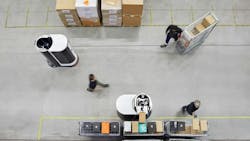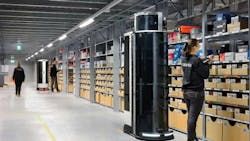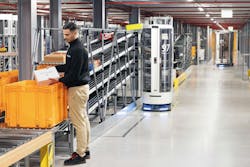Zalando (Berlin, Germany), a major European online fashion and lifestyle shopping platform, has augmented its logistics operations with mobile robots.
Founded in 2008, Zalando is a consumer-facing online shopping platform, specializing in apparel and lifestyle products. The company sells and ships goods directly to consumers located across some 25 countries throughout Europe.
In 2018, Zalando first deployed two TORU model robots developed by Magazino (Munich, Germany), a robotics company that specializes in e-commerce and intralogistics solutions. Equipped with LiDAR, laser scanner, 2D and 3D camera sensors, the robots can autonomously navigate around a warehouse area and find target objects.
Each TORU robot is 1375 (l) x 685 (w) and 1930 (h) mm, although the robot can extend its height to 2912 mm. The robot, which has eight storage shelves, can carry up to 16 items—depending on object dimensions and weight—with a maximum cargo weight of up to 40 kg. Each robot has a vacuum arm that can lift objects of up to 390 x 280 x 145 mm and weighing up to 2.5 kg. The arm can grip objects from 80–2500 mm above ground, making it useful for reaching very low and very high storage shelf areas.
At Zalando, the fleet has grown since the first two were implemented; Zalando now has 57 TORU robots deployed in logistics centers in Erfut and Lahr, Germany, and Verona, Italy. The robots operate three shifts per day, six days per week, alongside humans, performing tasks that previously were ergonomically taxing for people.
“Before deploying the robots, human workers were responsible for tasks like bending down and stretching far up when picking products from the highest or lowest shelf levels,” Henrike Erb, Magazino’s senior communications manager, says. “The manual process was physically demanding and less efficient.”
Related: Amazon is Testing an Autonomous and Collaborative Robot
End to End Solution
The robots autonomously navigate the warehouse, find, identify, and retrieve items they have been assigned to retrieve and deliver those items to a predetermined destination. Basically, the process is as follows:
- A batch of picking orders is transferred from Zalando’s onsite warehouse management system (WMS) to TORU’s automatic robot control (ARC) system. The orders are transmitted from the ARC, via Wi-Fi, to individual robots.
- The robots, using cameras and sensors and assisted by AI algorithms, navigate the warehouse, identifying and locating target objects.
- The robots pick up these objects, in this case shoeboxes, and transport them to a predetermined location, such as a handover station connected to a conveyor. The robots also can place their items onto the conveyor for transport to a packing station.
Each robot is equipped with an onboard computer and multiple sensors, including laser scanners, 2D and 3D cameras, and safety laser sensors. To navigate the warehouse, the robots use two safety laser scanners. These scanners “see” potential obstacles and collisions by gathering data, which is analyzed using onboard reactive path planning algorithms, Erb says.
The robots also use distance sensors to quickly navigate the storage shelves, Erb says.The robots are equipped with 2D and 3D cameras, including Basler (Ahrensburg, Germany) ace acA1920-40gm cameras, which are 2.3 MPixel 2D cameras the robots use to gather data, such as barcodes and images of individual boxes, to identify individual target items.
According to Basler, “this process involves a cross-laser projecting two vertical laser lines onto the object being measured. The camera records the reflected laser beams and uses them to measure the object based on the position of the line in the camera image. This process is optimized for rectangular objects such as parcels or shoeboxes.”
The data gathered is analyzed and processed using AI-based algorithms.
Once the robot retrieves its load of items, it navigates to a handover station—usually either pick carts, flow racks, or conveyor belts—where it can either put down or pick up its load of boxes. TORU robots are versatile. For Zalando’s purposes, the TORU fleet is specifically designed for the task of finding and retrieving shoeboxes and can pick them from the lowest and highest levels of storage shelving, Erb notes.
Results
The expansion of the robot fleet relieves human workers from repetitive, ergonomically difficult tasks, thereby increasing morale and logistics efficiency, which ultimately extrapolates to better customer service and higher customer satisfaction, Marcus Daute, Zalando’s director of logistics product and strategy, says.
Cost savings are also significant, Daute says. “Through the use of the robots, picking costs can be reduced by 50% on average,” Daute says. “It’s a win-win situation for both employees and customers.”
About the Author
Jim Tatum
Senior Editor
VSD Senior Editor Jim Tatum has more than 25 years experience in print and digital journalism, covering business/industry/economic development issues, regional and local government/regulatory issues, and more. In 2019, he transitioned from newspapers to business media full time, joining VSD in 2023.



